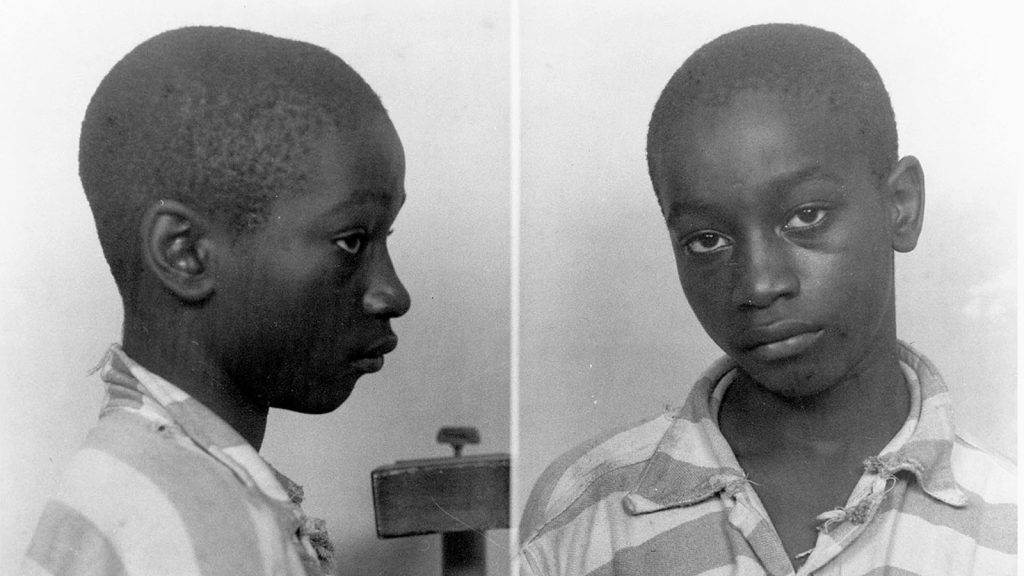
June 16, 1944 was execution day at the Central Correctional Institution in Columbia, and next on the docket to confront the electrical chair was George Stinney, a 14-year-old African American boy from Acolu, South Carolina. George weighed merely 95 pounds and stood at only 5” 1′ at the time he was strapped to an electric chair too big for his physique.1 Due to George’s small physique, extra holes needed to be punched into the chair’s leather bindings before the bindings could fit onto George’s limbs. This extra step bought George a couple extra minutes of life before he faced the electric chair.2 What was 14-year-old George Stinney thinking about right before execution? Surely not that he would soon become the youngest person executed in the 20th century.3

On March 24, 1944, tragedy and injustice came strolling into the small segregated lumber mill town of Alcolu, South Carolina. Betty June Binnicker, 11, and Mary Emma Thames, 7, were walking with their bike when they came across Aime Stinney Ruffner and George Stinney. The girls asked Aime and George whether or not they knew where they could find Maypops. Aime and George responded with a “no” and the girls went on their way. The night of March 24, Betty and Mary were reported missing after both girls failed to return home. The morning after, Betty June Binnicker and Mary Emma Thames were found dead in a ditch with their bikes laying on top of them. Police arrived at the Stinney household and arrested George, a 14-year-old African American boy, for the murders on Betty June Binnicker and Mary Emma Thames.4 Unfortunately, at the time police arrested George, the 1966 Supreme Court ruling on Miranda v. Arizona, which requires law enforcement officials to advise suspects of their rights, had not been ruled yet.5 After the police arrested and interrogated George without any access to his parents nor to an attorney, George confessed to the murders of Betty Binnicker and Mary Thame.6 George Stinney was not the only party impacted as a result of the murders, the Stinney family was persecuted by the rest of the town due the accusation against George. George Stinney Sr. was fired from work and the entire family was forced to permanently leave Acolu and move to Pinewood where the grandmother resided. Aime Stinney Ruffner stated, “We had no choice, the crowd came and they said they were going to get us.”7
The judge presiding over the case appointed Charles Plowden, 31-year-old local lawyer and aspiring politician, to represent George Stinney during the trial. On April 24, 1944, residents of Alcolu packed the local courthouse hoping justice would be served swiftly. A jury composed of 12 white men would be destined to determine George Stinney’s fate.8 Plowden failed to motion for a change of venue, which is a motion to change the location of a trial to overcome local prejudice. Stinney could have had a less partial jury in a different location. The prosecution’s case relied on the testimony of two police officers giving an account of Stinney’s confession he made during his interrogation. According to the police, Stinney confessed to having followed Betty Binnicker and Mary Thames after initially making contact with the girls, then unsuccessfully attempted to rape Betty, and then proceeded to beat both Betty and Mary with a railroad spike that had been laying around. The prosecution presented Stinney’s birth certificate as the last piece of evidence. The prosecution presented the birth certificate to make the case that Stinney was born on October 21, 1921, making him 14 years of age, which was traditionally the accepted age of criminal responsibility at the time.9 Plowden failed to cross-examine the prosecution’s witnesses, call forth any witness that could have corroborated with Stinney’s alibi, question the circumstances under which the police obtained the confession, nor to point out the lack of physical evidence, nor to point out the impracticality of a 14-year-old boy weighing 95 pounds and standing at 5 feet and 1 inch of physically being able to murder two girls, and finally failed to file an appeal. Plowden’s only defense comprised of the defendant being too young to be held responsible for the crimes he committed. Stinney’s trial, that would determine whether he lived or died, lasted a total of 3 hours. The judge sentenced the jury to deliberation, and 10 minutes later the jury comprised of 12 white men, found 14 year old George Stinney guilty of the murders of Betty June Binnicker and Mary Emma Thames. The judge sentenced George Stinney to death by electrocution. On June 16, 1944, the 2,400 volts of electricity passing through George Stinney rendered his body lifeless.10

70 years after the execution of George Stinney, Stinney’s three remaining siblings are seeking justice of their own with the help of a group of lawyers and civil rights advocates determined to exonerate Stinney. Stinney’s prosecution combined unconstitutional errors with serious misconduct. The team of attorneys argued in the Sumter County Courthouse that Stinney’s verdict was solely based on a coerced confession, therefore, the verdict should be thrown out.11 Due to new testimony, Stinney’s family, along with the team of attorneys, are hoping Judge Carmen T. Mullen, of the Fourteenth Circuit Court in South Carolina, rules in their favor. Despite most of the evidence, including Stinney’s confession and the transcript of the trial disappeared, Mullen heard new testimony from Stinney’s brothers and sisters, a witness from the search party, a child forensic psychiatrist, and a statement from Wilford Hunter, Stinney’s former cellmate.12 Frankie Bailey Dyches, the niece of one of the victims, stated, “He (George Stinney) was tried, found guilty by the laws of 1944, which are completely different now—it can’t be compared— and I think that it needs to be left as is.”13 Circuit Judge Carmen Mullen makes an important distinction in the Stinney case by stating that her task is not deciding whether Stinney is guilty or innocent, but rather to decide whether or not Stinney received a fair trial. On December 10, 2014, Circuit Judge Carmen Mullen vacated George Stinney’s conviction. Mullen ruled that Stinney’s confession was likely coerced and therefore inadmissible, “due to the power differential between his position as a 14-year-old black male apprehended and questioned by white, uniformed law enforcement in a small, segregated mill town in South Carolina.”14
George Stinney was tried, convicted of murdering two young White girls, and sentenced to death by electrocution, all in a single afternoon. The story of George Stinney showcases the irreversible actions that occur in a flawed criminal justice system that implements the death penalty primarily against minorities. The court system failed to provide George Stinney with a fair and impartial trial in 1944. As a result, George Stinney paid the ultimate price, death. 70 years after the death of Stinney, the Fourteenth Circuit Court in South Carolina ruled justly by vacating Stinney’s conviction. That moment on June 16, 1944 when 2,400 volts of electricity passed through Stinney’s body, it rendered him lifeless. The death of George Stinney sealed his fate in history as the youngest person executed in the 20th century. The finality of the death penalty by definition continues to risk the loss of innocents’ lives.
Warning: the video linked below is a very realistic, violent, and disturbing set of images of what the suffering and execution must have felt to young George Stinney Jr.
- Elaine Aradillas, Jill Smolowe, Howard Breuer, Michelle Boudin, “A Family’s Quest for Justice Wrongfully Executed,”(People, March, 2014), 73. ↵
- Charles Kelly, “Next Stop, Eternity,” (Life Rich Publishing, April 27, 2016), …. ↵
- Jesse Wegman, “A Boy’s Execution, 70 Years Later,” (New York: New York Times, June, 2014), 8. ↵
- Elaine Aradillas, Jill Smolowe, Howard Breuer, Michelle Boudin, “A Family’s Quest for Justice Wrongfully Executed,”(People, March, 2014), 75. ↵
- Miranda v. Arizona, 384 US 436 (1966). ↵
- Elaine Aradillas, Jill Smolowe, Howard Breuer, Michelle Boudin, “A Family’s Quest for Justice Wrongfully Executed,”(People, March, 2014), 75. ↵
- Elaine Aradillas, Jill Smolowe, Howard Breuer, Michelle Boudin, “A Family’s Quest for Justice Wrongfully Executed,”(People, March, 2014), 74. ↵
- Mark Kantrowitz, “The Killing of George Stinney Jr.,”(Rhode Island: Rhode Island Lawyers Weekly, 2018). ↵
- David Bruck, “Executing Teen Killers Again,” (The Washington Post, September 15, 1985). ↵
- Mark Kantrowitz, “The Killing of George Stinney Jr.,”(Rhode Island: Rhode Island Lawyers Weekly, 2018). ↵
- Jesse Wegman, “George Stinney was Executed at 14,” (New York: New York Times, January 12, 2015), 9. ↵
- Lindsey Beaver, “It took 10 minutes to convict 14-year-old George Stinney Jr. It took 70 years after his execution to exonerate him,” (The Washington Post, December 18, 2014). ↵
- Jesse Wegman, “George Stinney was Executed at 14,” (New York: New York Times, January 12, 2015), 8. ↵
- Brad Knickerbocker, “Executed at Age 14, George Stinney Exonerated 70 Years Later,”(Christian Science Monitor, December, 2014). ↵



97 comments
Sarah Uhlig
It is chilling to read the story of this young boy and how he was executed. I can’t believe how he was treated by the governmental justice system because of his race and how his family was treated because of this. It is all so wrong to read about how these people were treated and how someone could be capable of murdering these two young girls. It is all such a horrific story for all of the deaths mentioned in the writing.
Averie Mendez
Although the circumstances were pretty different, I can’t help see similarities to Emmett Till. Both boys were the same age and suffered a premature and unjust death. To put George on trial and condemn him to death all within three hours is inhumane. Although the criminal justice system today has its faults, it’s comforting to know how far it’s grown.
Christopher Hohman
Nice article. I feel so bad for George. It is so sad that he had his life, and all that that might have been taken away from at such a young age. It is terrible that he was coerced to give a confession. I cannot help but think that the jury had no problem convicting him because of his skin color. It is just so sad that they were so prejudiced against him. I am glad that George’s family got some justice for him. Even if it took seventy years. Still though that cannot bring him back to live the life he should have lived.
Erika Jackson
I’m speechless after reading this article. I can’t believe that the justice was that bad back in the day. That they arrested a 14-year old boy, convicted of rape and murder, then tried him to death sentence all in one day. This story is so sad, but I’m glad to see how much we grown as a country in our justice department so misunderstandings like this one won’t happen again. I’m happy that even though it was like 70 years later, he got the justice he deserved and was exonerated. I am curious though, did they ever find who actually killed those two little girls or is it still a mystery?
Krystal Rodriguez
I can not believe a 14 year old boy could kill two girls and i can believe even less that they would trial and execute him all in one day. There was so much more to do before deciding the poor young boy should die. His family must have been devastated and those people who decided he deserved to die must feel guilty. The real question now is, if he didnt do it, who killed those two girls and why?
Emily Velazquez
Reading this article made me realize the drastic change in the modern judicial system. The fact that a 14 year old boy was sentenced to death for execution with one trial that was decided upon in 24 hour is crazy to think about. There was so much unfairness that I read about in this young boy’s story. The video, I thought, was a great thing to add into this article. It really intensified things for me.
Vanessa Sanchez
Impressive article. I have been left speechless. It’s impressive to see how much we have grown as a country. Justice is now different compared to 75 years ago. It’s crazy to even think about a 14 year old boy put into a death penalty. The fact his life was decided in only 3 hours is just unacceptable or at least it is to the new justice.
Paola Arellano
This was a truly interesting article. To think that the justice system was so corrupt and biased at some point is insane and these are situations that could unfortunately still occur today. It is amazing that George Stinney’s siblings are trying to find justice for their brother as it shows the unity and willingness to not only clear their brother’s name but also bring awareness to those that do not know any better. What is better about the justice system is the obvious Miranda rights that must be said to anyone being arrested for a crime. It proves evolution in our justice system so that no one accidentally incriminates themselves for something they did not commit as George Stinney did not knowing any better.
Leeza Cordova
This greatly written article really showed how much our system has not only failed many people in the past, but has also changed alot. It is very sad to think that a very young boy was put to death due to confessing something that he was not even old enough to understand. I am glad that his family is going to the extent to get justice for him. This article kept me very attentive to the details and I am surprised that I have not heard about this case yet, since it is a very interesting one.
Chelsea Alvarez
This article was definitely an eye opener. George was so young and the justice system, or lack of justice, failed him immensely. Throughout reading this article, I wondered how George was able to murder those two girls being that he only weighed 95 pounds. It seems strange that the jury that deliberated this case sentenced him so quickly without the use of witnesses. Luckily, laws have changed and if a situation like this arises that person will be given a just trial.